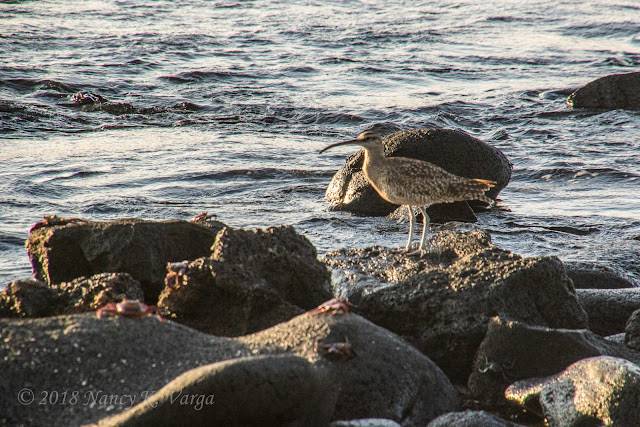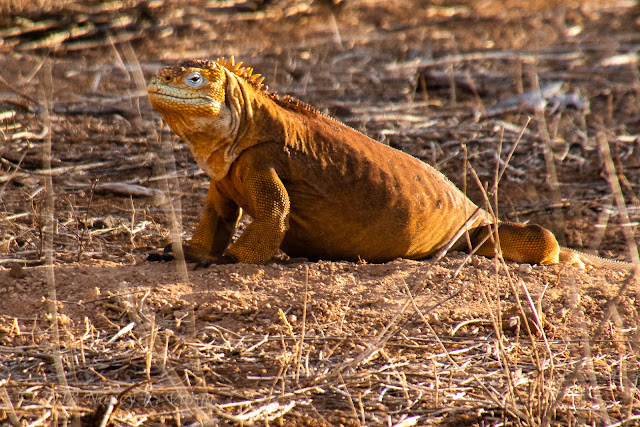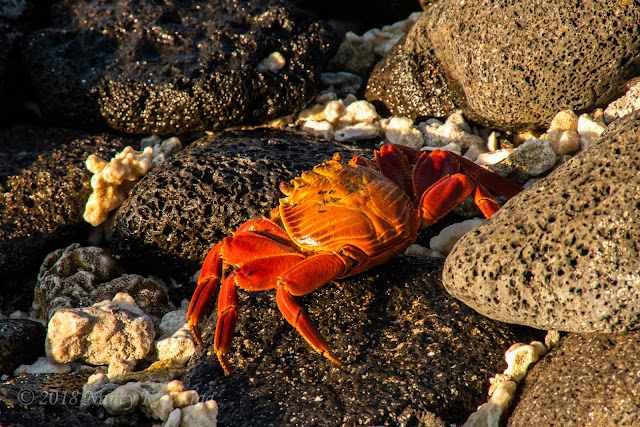DECEMBER 10:
This morning we visited Bartolomé Island. We ascended a boardwalk to the Pinnacle Rock overlook.
The slope is dotted with the tiquilla plants, a gray brush which appears to be dead, is actually made of leaves covered with small gray hairs which help prevent moisture evaporation and reflect sunlight. The common name is crinkle mat, and is a member of the forget-me-not family.
 |
| LARGE PAINTED LOCUST |
 |
| TEQUILLA PLANTS |
Some evidence of volcanic activity on the island:
We climbed to the peak of this island for a magnificent view of the island and Pinnacle Rock.
Pinnacle Rock is an immense spearheaded obelisk rising from the water surface.
 |
| PINNACLE ROCK |
At the base of the rock , and along its volcanic ledges one can usually spot the only species of penguins living North of the equator.
As you can see there are two lovely white sand beaches. Upon returning to the ship a number of us went snorkeling here for the chance to swim with the Galapagos Penguin before lunch. This was my second venture at snorkeling, and it went much better with Reneé pulling me along as I held onto a life ring. However, I was not lucky enough to swim with the penguins. I enjoyed the adventure and was able to take a couple of photos of different fish species I saw underwater.
While we had a delightful lunch the ship motored to Sullivan Bay on Santiago Island. Once again there was snorkeling, deep water, which was not for me. Later in the afternoon we went for a walk along the shoreline. The sea lions were both lounging and frolicking.
They enjoyed lounging in the vegetation as well.
This vegetation looks a bit like iceplant but is a shoreline purslane.
As daylight ended, we boarded the pangas and returned to the ship as we have to be off the islands by 1800. But before that I had to take in the colorful sally lightfoot crabs.
As daylight ended, we boarded the pangas and returned to the ship as we have to be off the islands by 1800. But before that I had to take in the colorful sally lightfoot crabs.
 |
| WHIMBREL |
The shoreline views were of interest as well.
DECEMBER 11:
Overnight we moved to the shore of very small Rabida Island, located South of Santiago Island. This island is known for its red sand beaches which are a made of sand eroded from cinder cliffs to the west. The shoreline is rimmed with mangrove plants and saltbush. A walk along the beach was very pleasant with sea lions and pups, lava lizards, mockingbirds, shells, etc.
 |
| OPUNTIA |
 |
| PALO SANTO TREES FRAMING THE S.S. MARY ANNE |
 |
| ARE WE RELATED? |
 |
| BALANCING ACT |
I participated in the snorkeling this morning, and was rewarded with seeing a stingray, and several varieties of fish.
 |
| MATE NANCY |
 |
| MATE GEORGE |
In the afternoon we visited Santa Cruz Island.
Marine iguanas are black and have a blunt face which is used to scrape food, seaweed and algae off the rocks and ledges under water.
 |
| MARINE IGUANA SUNNING |
 |
| MARINE IGUANA ENJOYING THE VIEW |
 |
| OPUNTIA BLOSSOMS |
 |
| GALAPAGOS MOCKINGBIRD |
 |
| LAND IGUANA |
 |
| WHITE-CHEEKED PINTAIL |
 |
| SMALL LAGOON |
 |
| MARINE IGUANA SWIMMING |
 |
| MARINE IGUANA |
There was the possibility of seeing some flamingoes, but there were none to be seen. Along one of the beaches we saw a number of the colorful sally lightfoot crabs.
DECEMBER 12:
Overnight I was struck with “Montezuma’s Revenge” with several calls to the toilet. In the morning I reported it to our leaders and soon I was being shuffled off to the local hospital. The result was that I was diagnosed with dehydration, and given an I.V. to get me back on my feet. This was not a Mayo clinic facility. Outside was one of their wheelchairs.
In the E.R. space there were several gurneys with thin sheet coverings which were not changed with each patient.
In the E.R. space there were several gurneys with thin sheet coverings which were not changed with each patient.
Reneé had called our ship and they sent over two clean sheets and a pillow case. When I went to the bathroom there was no seat cover on the toilet. All went well for me, and I was soon on my way back to the ship,
where I slept most of the rest of the day away. The crew made me a delicious soup for lunch, and I was instructed to hydrate with juices, etc.
where I slept most of the rest of the day away. The crew made me a delicious soup for lunch, and I was instructed to hydrate with juices, etc.
In the mean time George went off to the highlands of Santa Cruz Island to see the giant tortoises and visit the Darwin Research Center.
The following write up and photographs are by George:
December 12, 2018
A refreshing start of the day with breakfast at 07:15 hours instead of the usual 05:15 start. Then instead of a wet landing ashore, we had a dry landing on Santa Cruz Island. Unfortunately Nancy was stricken with having to go too often to the commode and became dehydrated. The Captain of the vessel arranged to have her check in to the local hospital which turned out to be an adventure by itself. She was off the ship so fast that I was not aware of her absence and went looking for her. I ran into the Captain who informed me that she was heading for shore with Renee and Sandra, the Park Ranger. After being taken care of, she returned to the ship and missed the day ashore.
Upon landing on Santa Cruz Island at Puerto Ayora, we encountered sea lions lounging and snoozing on benches at the landing site.
Upon landing on Santa Cruz Island at Puerto Ayora, we encountered sea lions lounging and snoozing on benches at the landing site.
These tunnels or lava tubes are formed by hot molten lava flowing
through an area. The outer surface of the molten lava stream is cooled faster and hardens while the interior continues to flow until it reaches the Earth surface. The end result is that a hollow tunnel or tube is left behind.
While walking about, we encountered wild tortoises. These 600 pound creatures roam free among the cattle that inhabit the local ranches in the highlands.
 Instead of returning to the ship for lunch, we had a light lunch at one of the ranches while we watched for tortoises, iguanas, and birds.
Instead of returning to the ship for lunch, we had a light lunch at one of the ranches while we watched for tortoises, iguanas, and birds.
After lunch we were driven back to Puerto Ayora where we first visited the Charles Darwin Research Station. The first stop was in the Gift Shop where the main goal of our group was to look for souvenirs. “T” Shirts were probably the most sought after item. From the Gift Shop we ambled over to the Tortoise Rearing and Observation area. At this facility eggs are incubated, hatched and the young tortoises are reared until mature enough to be relocated to their native island in the Galapagos.
From the Research Station we walked back to the landing docks and the town shopping area. A very interesting and quite entertaining point of interest was the Fish Market. Here you
could purchase all kinds of fresh seafood but also be entertained by the resident beggars who were not necessarily homeless. They just like to hang out where the action is and hope for a hand out.










































Bummer about getting sick. Otherwise, WOW, what you're seeing is amazing. My problem with snorkeling was getting cold even in warm Caribbean waters. So cool to pilot the ship, which is awesome looking.
ReplyDeleteThank you George and Nancy. The photos you share from all your travels produce nothing but joy. They stimulate the senses
ReplyDeletewhile at the same time bring a calmness that I seem to constantly be seeking. I can't thank you enough